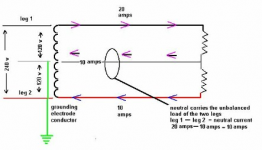PbMXer_218
Member
- Location
- Largo, Florida
- Occupation
- Licensed Electrician EC
Good afternoon! 2017 NFPA 70, 310.15 (5) A neutral conductor that carries only the unbalanced load from conductors of the same circuit shall not be required to be counted when applying the provisions of 310.15(B)(3)(a). For NFPA 70 2020 THE REFERENCE IS 310.15(C)(E). Both basically say the same thing.
With that said, my question is when does this rule apply? For example, if we have a multi-branch circuit like an oven that requires a neutral, then the neutral is not required to be counted?
Also, if you have a 120V circuit that is drawing 6 amps, the neutral would also carry 6 amps. This would be a balanced circuit. To be quick and to the point, when does 310.15(5) apply?
When you read further, it talks about multi wire b ranch circuits and basically sys it must be counted. I am trying to understand when this rule can be applied. And if a dedicated circuit is carrying the same load from phase conductor and neutral conductor why are we required t count the neutral as current carrying. This rule is deceiving to me. I do not understand when and how to apply it properly.
TIA
With that said, my question is when does this rule apply? For example, if we have a multi-branch circuit like an oven that requires a neutral, then the neutral is not required to be counted?
Also, if you have a 120V circuit that is drawing 6 amps, the neutral would also carry 6 amps. This would be a balanced circuit. To be quick and to the point, when does 310.15(5) apply?
When you read further, it talks about multi wire b ranch circuits and basically sys it must be counted. I am trying to understand when this rule can be applied. And if a dedicated circuit is carrying the same load from phase conductor and neutral conductor why are we required t count the neutral as current carrying. This rule is deceiving to me. I do not understand when and how to apply it properly.
TIA


